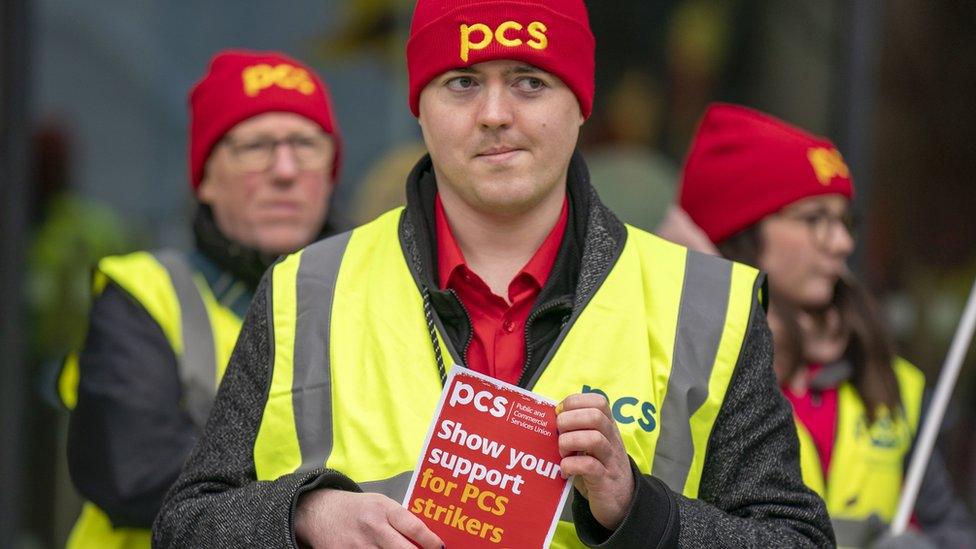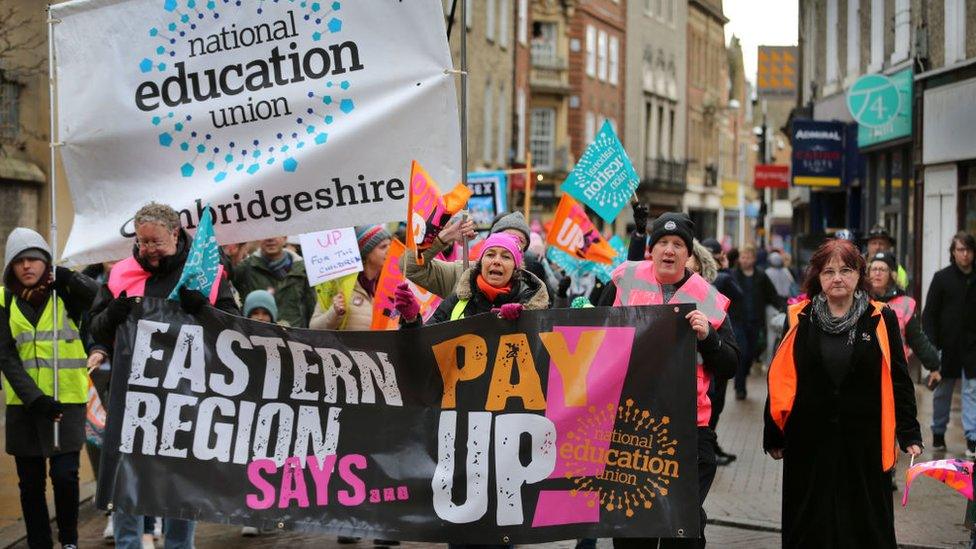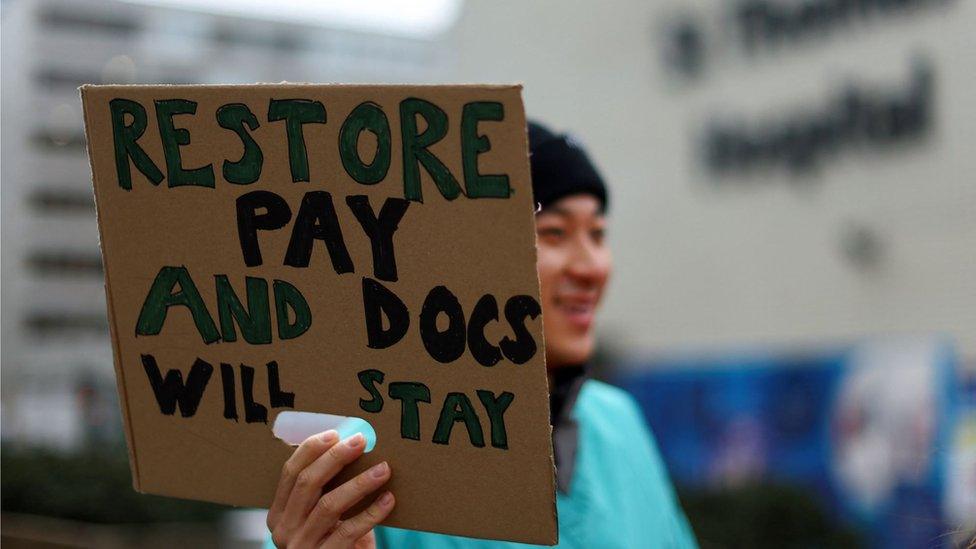What has happened to pay in the UK?
- Published

Wages have failed to keep up with the rising cost of living for many UK workers, prompting a wave of strikes in recent months.
Figures suggest the picture is much worse in some professions than others, with teachers, doctors and nurses seeing more pay lost to inflation than workers in other sectors.
BBC News analysed the latest salary figures from the Office for National Statistics (ONS) up to March 2022, to see how wages in different professions compare to the overall average, and to find out how far pay for train drivers, paramedics, civil servants and others, has kept up with prices.
These figures do not factor in the rapid increase in inflation after March 2022, or how wages have changed since then.
What is the average employee paid?
The wage of an average full-time employee stood at about £33,000 in the year to March 2022, having risen by about a quarter over the ten years until then. At this point wages had risen above inflation by about £1,250.
You can see average pay across a range of sectors where workers have take part in strike action using the interactive chart below.
This is an average across each job category captured in the ONS survey, some of which include many different individual jobs. It may also include both those with and without London weighting in the average. The survey is made up of both public and private sector workers.
Your device may not support this visualisation
Teachers

The average salary for secondary school teachers fell behind rising prices by about £2,400 over the 10 years to March 2022.
The average secondary teacher earns more than the average overall worker: just under £42,000 last March. But had this salary kept pace with rising prices over this period, this figure would be more than £44,000.
The ONS does not produce data for every type of teacher. But the picture for "teaching professionals" overall, which includes primary schools and university teaching staff, looks very similar to what has happened in secondary schools. They had an average wage of just under £41,000 but this was £3,200 behind the rise in prices since 2012.
Junior doctors

Junior doctors are asking for a 35% pay rise
The average earnings for a junior doctor in England in the year to March 2022 was just over £55,000, according to a separate analysis by the Nuffield Trust, external.
The salaries of both junior and senior doctors are combined in the ONS's data, and so the BBC is not able to analyse them in the same way as other careers.
Senior doctors are not striking and are in the top 2% of earners in the UK.
Junior doctors earn well above the average salary in England, but the Nuffield Trust estimate that their pay has fallen behind inflation by nearly £5,000 since 2011.
This is a smaller fall than the headline figure used by the junior doctors' union, the BMA, but still larger than many other groups of workers, based on the ONS data.
Civil servants

PCS union members on strike at Cardiff Airport
The wages of the most junior civil servants, or "national government administrative occupations" as the ONS calls them, have kept up with rising prices, but they are not well off.
For this job category the average full-time salary was about £27,700 in the survey. That's about £2,400 more than if the salary had just been increased by inflation over the past decade. But it is still well below the national average.
This is also a very broad category which includes many different jobs within the civil service, both inside and outside London. For those in jobs on the lower end, starting salaries can be lower, at about £21,000, but this isn't shown in the average for the broader category.
The Public and Commercial Services Union (PCS) say they've prioritised the wages of the least well off when negotiating with bosses in the civil service.
On the next rung up are mid-level "associate professionals". Their average salary was about £2,400 above the national average last March. Its growth also outstripped rising prices, but by much less than their junior colleagues, at £720.
Who else is currently in negotiations?
There are other workers represented in the data who have been poised to take, or have taken, strike action over the past few months, such as physiotherapists, ambulance staff, nurses and rail workers. Some are currently in pay negotiations with their employers.
A new pay deal has been offered to NHS staff in England except doctors, which trade unions are recommending to members. Firefighters, who had threatened strike action, recently accepted a new pay deal.
Broadly, the average salary of a nurse is a few thousand pounds higher than the national average, but, as of March 2022, their average pay had not quite kept up with rising prices.
For a full-time paramedic, the average salary last March was nearly 50% higher than the average worker's salary and had grown by about £5,000 more than prices in the last 10 years. But unions say part of that growth is due to NHS pay scales. In 2016 paramedics were moved up a band to reflect changes in their jobs.
Meanwhile, the pay of ambulance drivers and emergency medical technicians has not kept pace with rising prices. They earned about £27,500 as of April 2022, which was nearly £300 less than if their pay had risen with inflation.
While train drivers do well, with average pay that has risen £5,300 above inflation, not all rail workers have seen the same level of growth.
Rail travel assistants, a category which includes ticket inspectors and station attendants, saw wages rise above inflation by about £1,300 up to 2022, earning nearly £38,000 per year.

Methodology
The salary data used in this analysis comes from the latest Annual Survey of Hours and Earnings, external (ASHE) from the ONS.
We used gross annual pay for the average full time worker in each profession, using the median average. For inflation we used the average of monthly CPIH, external in the 12 months to March.
Nuffield Trust's figures were based on figures for NHS England, external and used a different measure of inflation called CPI, external that has grown slightly faster than CPIH.
Where job names or codes changed from one year to the next, we used this lookup tool, external developed by Warwick University to match jobs.
The coronavirus pandemic affected the survey figures for 2020 and 2021 due to various factors, including furlough. The ONS suggests treating these figures with greater caution.
The salary is the pay of the average worker, rather than a precise measure of terms and conditions, pay bands or starting salaries. It includes overtime, bonuses or allowances for anti-social hours and covers workers in the public or private sector. Increases can be caused by things other than raises. These include a shift in seniority (lower-paid workers leaving the profession) or in working hours (more people doing overtime).
The growth in average pay is likely to underestimate pay growth for an individual worker who may get promoted and move from being below-average to above-average within their profession.
In the chart at the top of the story we refer to "junior level" and "mid level" civil servants. The ASHE descriptions for these jobs are national government administrative occupations (junior) and public services associate professionals (mid).
Additional reporting by Becky Dale, Libby Rogers, Zoe Conway and Robert Cuffe

Correction 27 April: The figures in an earlier version of this story included prices rises that occurred after March 2022. They have now been corrected throughout to compare salary and price growth on a like-for-like basis: until March 2022, the latest available date for salary figures.
- Published1 August 2023
